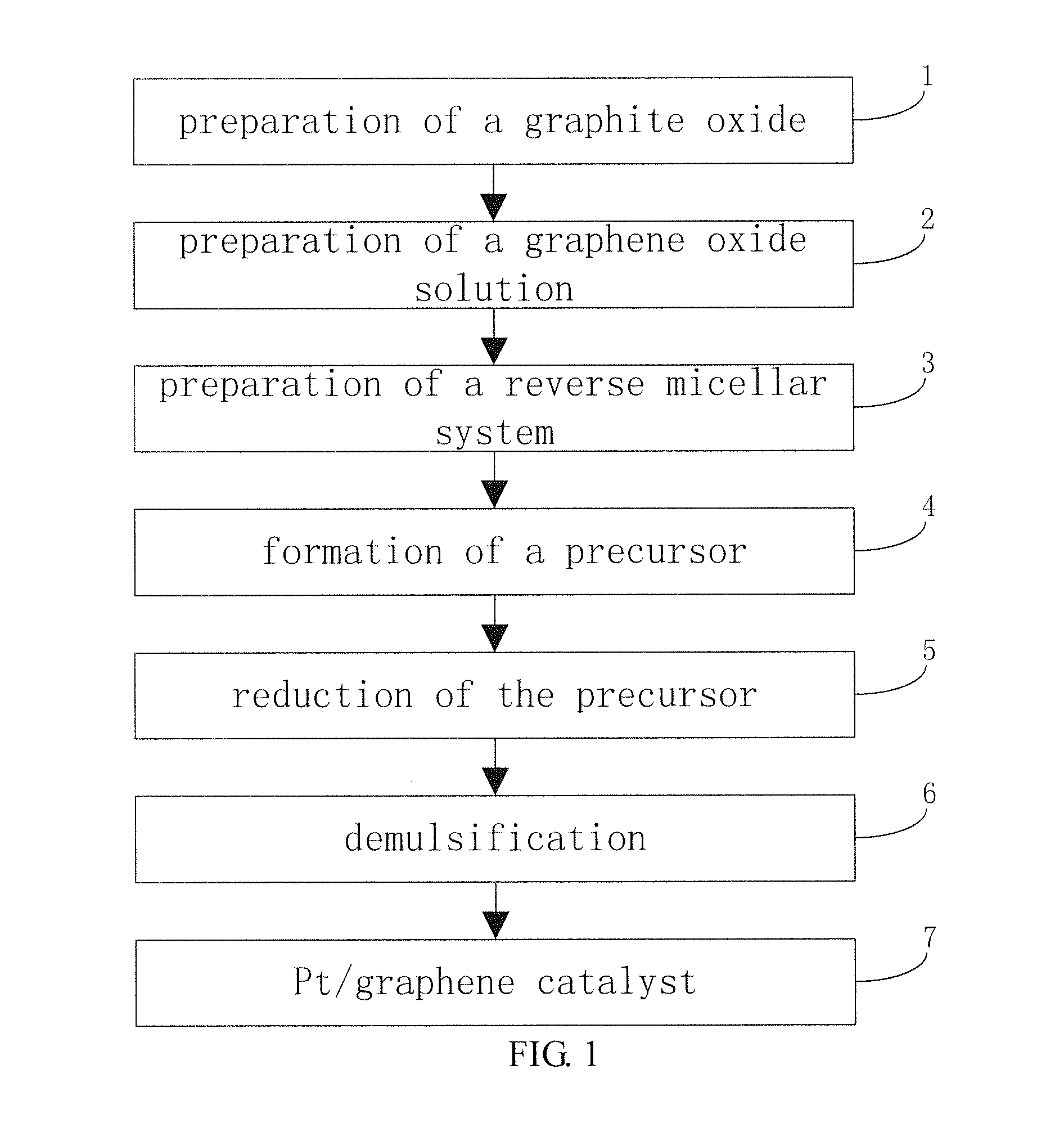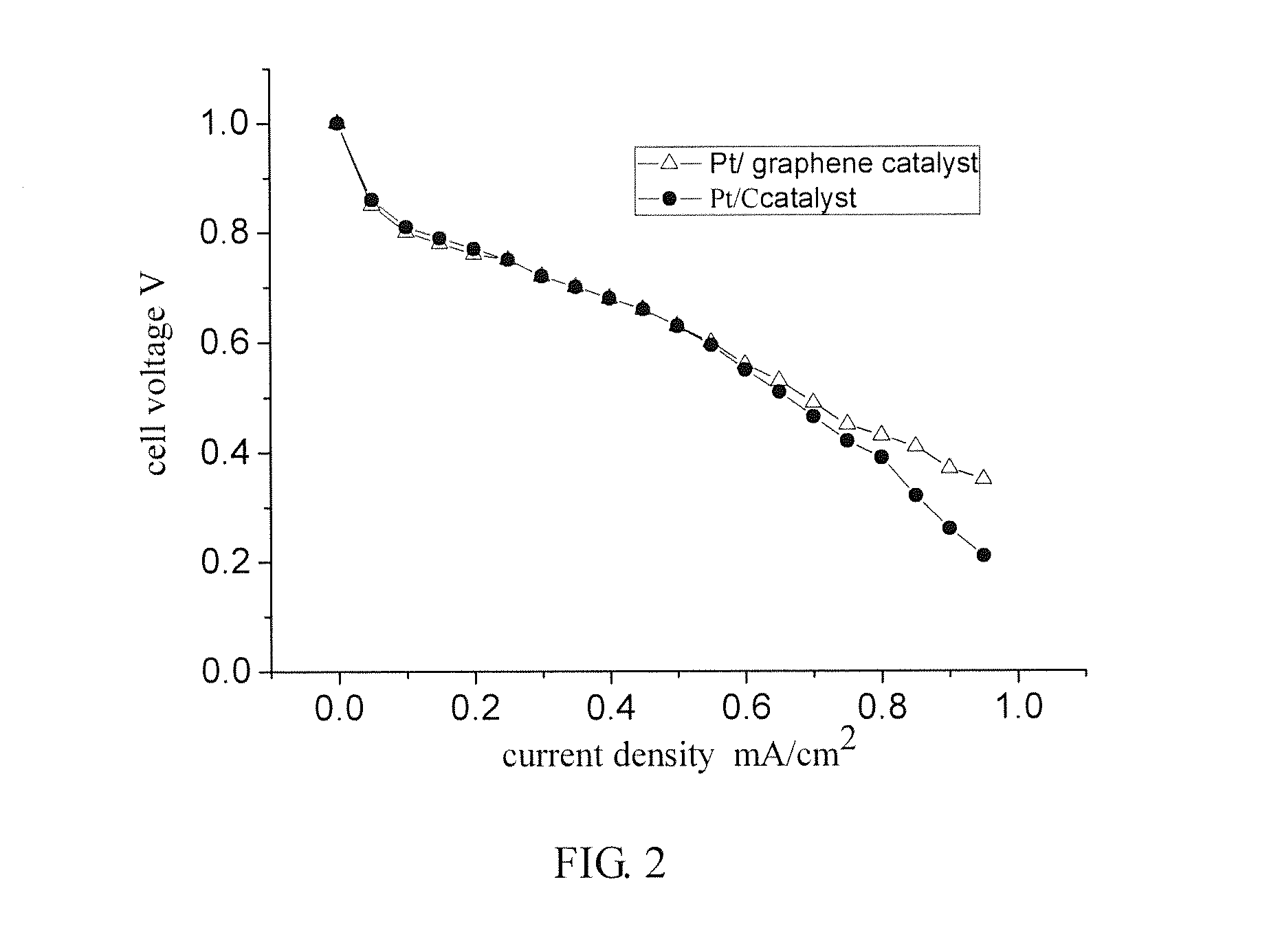Pt/graphene catalyst, preparation method and use thereof
a graphene catalyst and graphene technology, applied in the field of electrochemical energy, can solve the problems of poor particle dispersion, uneven particle diameter, relatively harsh reaction conditions, etc., and achieve the effects of increasing the stability of the catalyst, and reducing the number of catalysts
- Summary
- Abstract
- Description
- Claims
- Application Information
AI Technical Summary
Benefits of technology
Problems solved by technology
Method used
Image
Examples
example 1
[0036]1. Preparation of a graphite oxide: a graphite oxide was prepared according to modified Humers method. The specific steps included: 20 g of 50 mesh graphite powder, 10 g of potassium persulfate and 10 g of phosphrous were added into concentrated sulfuric acid at a temperature of 80° C., and then the mixture was stirred uniformly, cooled for more than 6 hours, washed to neutral and dried to obtain a sample. The dried sample was added into 230 mL of concentrated sulfuric acid at a temperature of 0° C., then 60 g of potassium permanganate was added, the mixture was maintained below 20° C. for 30 minutes, after being maintained in the oil bath at a temperature of 35° C. for 2 hours, 920 mL of deionized water was slowly added. After 15 minutes, 2.8 L of deionized water (containing 50 mL of hydrogen peroxide with the concentration of 30%) was added, the mixture was hot filtrated when the color of the mixture became bright yellow, and then washed with 5 L of hydrochloric acid with th...
example 2
[0044]1. Preparation of a graphite oxide: a graphite oxide was prepared according to modified Humers method. The specific steps included: 20 g of 50 mesh graphite powder, 10 g of potassium persulfate and 10 g of phosphrous were added into concentrated sulfuric acid at a temperature of 80° C., and then the mixture was stirred uniformly, cooled for more than 6 hours, washed to neutral and dried to obtain a sample. The dried sample was added into 230 mL of concentrated sulfuric acid at a temperature of 0° C., then 60 g of potassium permanganate was added, the mixture was maintained below 20° C. for 30 minutes, after being maintained in the oil bath at a temperature of 35° C. for 1 hours, 920 mL of deionized water was slowly added. After 15 minutes, 2.8 L of deionized water (containing 50 mL of hydrogen peroxide with the concentration of 30%) was added, the mixture was hot filtrated when the color of the mixture became bright yellow, and then washed with 5 L of hydrochloric acid with th...
example 3
[0051]1. Preparation of a graphite oxide: a graphite oxide was prepared according to modified Humers method. The specific steps included: 20 g of 50 mesh graphite powder, 10 g of potassium persulfate and 10 g of phosphrous were added into concentrated sulfuric acid at a temperature of 80° C., and then the mixture was stirred uniformly, cooled for more than 6 hours, washed to neutral and dried to obtain a sample. The dried sample was added into 250 mL of concentrated sulfuric acid at a temperature of 0° C., then 60 g of potassium permanganate was added, the mixture was maintained below 20° C. for 60 minutes, after being maintained in the oil bath at a temperature of 35° C. for 2 hours, 920 mL of deionized water was slowly added. After 15 minutes, 2.8 L of deionized water (containing 50 mL of hydrogen peroxide with the concentration of 30%) was added, the mixture was hot filtrated when the color of the mixture became bright yellow, and then washed with 5 L of hydrochloric acid with th...
PUM
| Property | Measurement | Unit |
|---|---|---|
| temperature | aaaaa | aaaaa |
| temperature | aaaaa | aaaaa |
| temperature | aaaaa | aaaaa |
Abstract
Description
Claims
Application Information
 Login to View More
Login to View More - R&D
- Intellectual Property
- Life Sciences
- Materials
- Tech Scout
- Unparalleled Data Quality
- Higher Quality Content
- 60% Fewer Hallucinations
Browse by: Latest US Patents, China's latest patents, Technical Efficacy Thesaurus, Application Domain, Technology Topic, Popular Technical Reports.
© 2025 PatSnap. All rights reserved.Legal|Privacy policy|Modern Slavery Act Transparency Statement|Sitemap|About US| Contact US: help@patsnap.com


